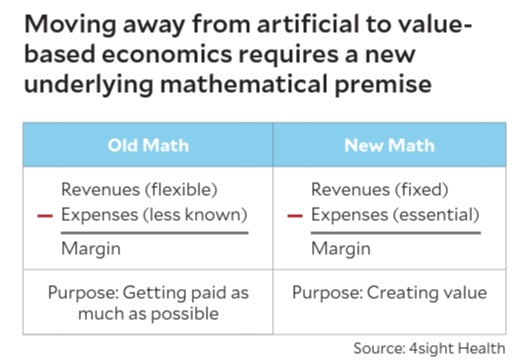David Johnson: Cracks in the foundation, Part 2: Overcoming healthcare’s artificial economics
Editor’s note: This piece is the second in a series of six columns in which David Johnson addresses five structural defects undermining nonprofit healthcare. He outlined all five defects in the first column of the series, which debuted in the February issue of hfm.

The first thing to do when you’re stuck in a ditch is to stop digging.
It’s evident that our healthcare system is beset with growing costs and inequities in access to healthcare. and most support the goal of achieving true cost effectiveness of health for all Americans. More of the same approach will yield more of the same dismal outcomes. It’s time to stop digging and confront healthcare’s structural challenges.
Take heart. Our history as a nation — and as a species — shows that solving big problems is one of our strengths, even if there are bumps along the way. But finding solutions starts with the willingness to question status-quo practices.
Let’s consider the major driver of our healthcare industry’s current disfunction: artificial economics based on the industry’s own special twist on the law of supply and demand.
Healthcare’s artificial economics
In normal markets, intrinsic demand for products and services at given prices drives supply. healthcare reverses the equation. The supply of healthcare facilities and practitioners propels demand for diagnostic and treatment procedures. More cardiac surgeons generate more cardiac procedures, irrespective of intrinsic market demand.
Although unique, supply-driven demand for healthcare services is not new. In the early 1960s, economist Milton Roemer observed, “[S]upply may induce its own demand in the presence of third-party payment.” Medicare’s creation in 1965 incorporated the third-party payment mechanisms that Roemer feared. Distortive and artificial supply-driven demand governs healthcare economics to the present day.
Sixty-plus years since Medicare’s creation, third-party, fee-for-service (FFS) payment subverts value-driven healthcare service delivery by doing the following:
- Compensating “reimbursable care” whether it’s appropriate or not
- Discouraging “appropriate care” when it’s not reimbursable
- Complicating treatment approvals
- Increasing administrative costs
- Distorting the buy-sell relationship between providers and consumers
Complexity and gaming dominate the intricate dance between payers and providers. Market concentration enables some payers and providers to gain concentrated pricing power. Monopolistic and monopsonist behaviors warp industry supply-demand dynamics and steal vital societal resources.
Healthcare’s artificial economics have created an inefficient, error-prone, wasteful and often ineffective delivery system that ignores consumer preferences. FFS payment induces supply-driven demand, inflates prices, fragments service provision and complicates billing mechanics. Illustrating the point, most hospitals are failing to comply with new price-transparency rules.
Meanwhile, adherence to healthcare’s artificial economics has enriched health systems. But that benefit comes at a cost, because it also makes them vulnerable to value-based offerings that deliver better outcomes at lower prices. Disruptive companies promoting retail and virtual care delivery are threatening profitable acute care service lines.
History is not destiny, however. Health systems that engage consumers, embrace transparency and optimize performance will thrive within healthcare’s evolving marketplace. They can win market share by delivering tangible value to consumers.
Healthcare’s new math
Delivering value-based care delivery is easier said than done. It requires:
- Cultural transformation within health systems that places consumers at the heart of organizational activity
- Managerial mindsets that link service provision with consumer needs
- New metrics to measure engagement, satisfaction, efficiency and costs
- New math, as illustrated below

In traditional healthcare economics (old math), revenues are flexible and subject to manipulation. This accounts for health systems’ enormous investment in revenue cycle capabilities. In FFS medicine, health systems win by optimizing revenues, not controlling costs: “Getting paid as much as possible” is the organizational mantra.
By comparison, in well-functioning markets (new math) the supply of products and services offered adjusts to intrinsic levels of customer demand at specific price points. Prices for commodity products and routine services are highly elastic. Higher prices reduce demand. Lower prices increase it. As the healthcare marketplace becomes more transparent and competitive, prices for routine care will coalesce around fixed price points.
Profitability requires effective expense management. Robust cost-accounting capabilities drive constant performance improvement, tight pricing algorithms and efficient resource utilization. Winning companies distinguish themselves by their ability to create value. They deliver high volumes of high-quality products and services at low prices with exceptional customer experience (think Amazon).
In the land of the blind, the one-eyed person rules. Health systems that abandon artificial, volume-driven economics and embrace real, value-driven economics will redefine the healthcare marketplace. They will gain customers, market share and brand strength by becoming more transparent, aligning prices with costs and delivering value to customers. As they transform themselves, these revolutionary health systems will harmonize mission and performance. They will sustain themselves by enriching the American people with kinder, smarter and more affordable healthcare services.
Gravity wins
Most healthcare services are routine. They occur frequently, have predictable outcomes and invite standardization. Fighting against commodity-based pricing for routine services is like fighting against gravity. It takes enormous energy and is doomed to failure.
To paraphrase a quote often attributed to Mark Twain: “It’s not what you don’t know that will kill you. It’s what you think you know for sure that just ain’t so.”
Healthcare incumbents believe current payment practices will continue for the foreseeable future. It just ain’t so.
The shift to risk-based payment models (full-risk bundles for episodic care and capitation for population health) normalizes healthcare’s supply-demand dynamics. With revenues largely fixed, health systems will generate profits in two ways: by delivering routine services efficiently at scale; and by delivering appropriate care services that promote prevention, engagement and community well-being.
Over the coming decade, consumers will exercise more control over their healthcare decision-making. They won’t need navigators. Technology and consumer-friendly applications will provide the information, guidance and access that consumers require to make smarter healthcare purchases.
Once unleashed, American consumers will become heat-seeking missiles for the value- based care services they need and want. As the healthcare marketplace normalizes, consumers will use well-honed purchasing instincts to find and reward higher-value providers.
A lesson — and a challenge — posed by market leaders
Cutting-edge health systems will build business models that deliver routine care efficiently and profitably. These are the organizations that are out in front when it comes to questioning the status quo. They will get ahead of the curve by giving customers the high-value care they increasingly demand. They will unleash their workforces to deliver on the promise of better healthcare for customers. Imagine the power of this focused effort.
These health systems will gain market share the old-fashioned way — by earning it.
7 strategies health systems can use to transform U.S. healthcare
Here are seven strategic stances that health systems can take to overcome their historic dependency on fee-for-service medicine, volume-based business models and revenue-first managerial mindsets:
- Accept that healthcare’s artificial supply-driven economics will disappear over time and that routine healthcare services are subject to commodity pricing.
- Focus on delivering better care outcomes at a lower cost by employing robust cost-accounting capabilities.
- Proactively seek risk-based contracts and partner strategically to expand organizational reach and capabilities.
- Create seamless, customer-friendly interfaces to guide consumer decision-making.
- Emphasize convenience, accountability and customer experience.
- Engage caregivers and employees in the just cause of delivering better health.
- Design new metrics that capture value creation broadly and specifically.





